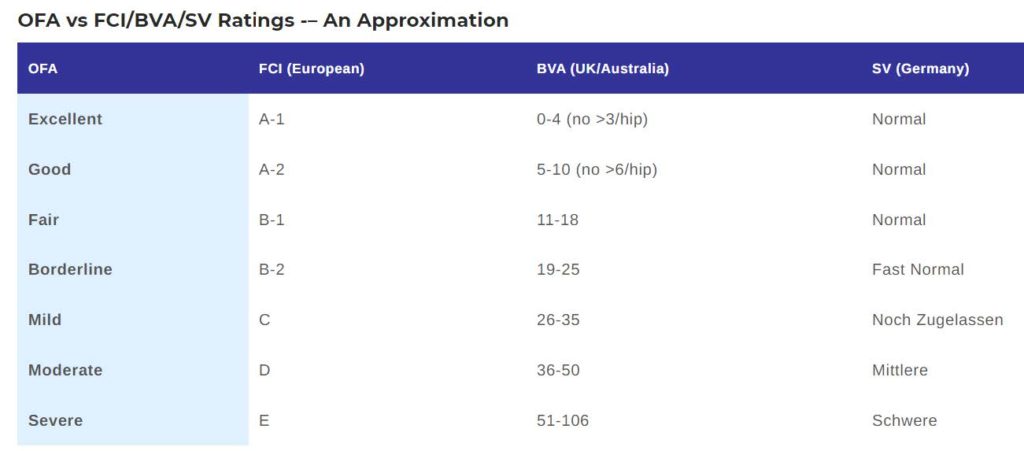Hip Evaluations
Differences in hip classifications
OFA uses a qualitative method because no form of measurement is utilized. Instead this method is based on subjective visual criteria such as degree of joint laxity (subluxation) and the presence of degenerative joint disease. The official evaluation can be conducted at 24 months of age and the dog does not have to be sedated for the procedure.
The radiologist will grade the hips with one of seven different physical (phenotypic) hip conformations: normal which includes “excellent”, “good”, or “fair” classifications, borderline or dysplastic which includes “mild”, “moderate”, or “severe” classifications. The final hip grade is decided by a consensus of the 3 independent outside evaluations.
Seven classifications are needed in order to establish heritability information (indexes) for a given breed of dog. Definition of these phenotypic classifications are as follows:
- Excellent
- Good
- Fair
- Borderline
- Mild
- Moderate
- Severe
OFA Results: Hips for dogs 24 months and older, dogs with permanent hip evaluations of “Excellent”, “Good” or “Fair” are considered passing.
“Borderline”, “Mild”, “Moderate” or “Severe” should not be bred.

Source: HIP INTERNATIONAL RATINGS MATRIX
PennHip is a quantitative and objective method performed under sedation. The technique assesses the quality of the canine hip and quantitatively measures canine hip joint laxity which means it measures the separation distance of the femoral head center (ball of hip) from the acetabular center (socket) while the hip joint is forced to luxate, then divides this measurement by the radius of the femoral head (ball of hip). In effect, this method evaluates how far the femoral head can be displaced from the acetabulum. The resulting number is termed the “distraction index” (DI). The DI score can range from 0 to 1 with scores closer to 0 indicating less hip laxity. Dogs receiving a score of less than 0.3 are considered to have normal hip-joint conformation with little, if no risk for degenerative joint disease.
PennHip evaluation can be performed after the age of 4 month. According to Antech Imaging Services and Dr. Gail K. Smith, VMD, PhD, Founder of the PennHip program and Director of the Pennsylvania Hip Improvement Program at the University of Pennsylvania School of Veterinary Medicine, studies* indicated the repeatability of PennHIP DI already at 16 weeks old dogs. Although the best repeatability measured in his studies was between 1 and 2 years of age, early imaging with already 16 weeks of age gave a pretty much reliable information about the dogs risk to develop degenerative joint laxity in his life.
Breeders are encouraged to re-evaluate the dogs hips with this method, especially when the “distraction index” is higher.
* Gail K. Smith et al.: “Coxofemoral joint laxity from distraction radiography and its contemporaneous and prospective correlation with laxity, subjective score, and evidence of degenerative joint disease from conventional hip-extended radiography in dogs” in American Journal of Veterinarian Research, Vol 54, No 7, July 1993
PennHip evaluations: are considered passing if the results indicate a “distraction index” (DI) that meets or exceeds the median DI for Lagotto as set forth in the PennHip Evaluation. PennHip recommends that early evaluations after 16 weeks of age can be used for Breeders as a screening tool when deciding to keep a puppy for potential breeding.
FCI, which is used by most European countries, classifies hips with the help of the Norberg Angle. The procedure is under sedation and performed by a certified veterinarian who is elected by the dog club. The measurements grades are:
>/= 105° is A
< 105° is B
>/= 100°is C
>/= 90° is D
< 90 is E
All three grading methods cannot be compared one to one as the age, anesthesia used and the method for taking the x-ray (position of the dog etc.) may affect the end result.
International hip evaluation: scores recommended as ‘passing’ for breeding are A or B. Dogs with a score below B are not recommended for breeding.
Note: Some countries allow breeding “C” rated hips provided they are bred to dogs with “A” rated hips.
